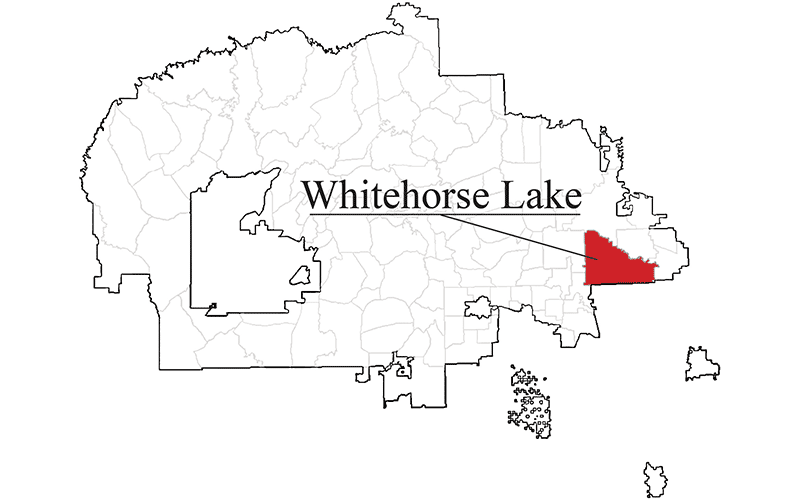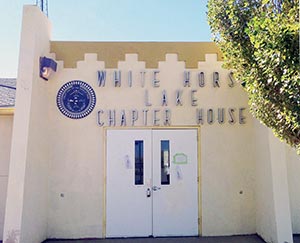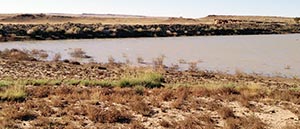
Going with the flow

Whitehorse Lake locator map
(Editor’s note: In an effort to chronicle the beauty and diversity of the Navajo Nation, as well as its issues, the Navajo Times has committed to visiting all 110 chapters in alphabetical order. This is the 108th in the series. Some information for this series is taken from the publication “Chapter Images” by Larry Rodgers. For the full series, view the Chapter Series archive here.)
Whitehorse Lake’s future is a tale of two pipelines
WHITEHORSE LAKE, N.M.

Whitehorse Lake Chapter’s art deco chapter house looks like something from the early 1900s but only dates to 1975. The chapter prides itself on keeping its buildings clean. (Times photo – Cindy Yurth)
Some chapters have big aspirations. Dennehotso wants to be the world’s best farm town; LeChee likes big boats and it cannot lie.
Here in Whitehorse Lake, though, folks are grateful for the little things — the Navajo-Gallup water pipeline that finally brought running water to the chapter early this year; the new cell tower that makes it possible to call the ambulance in Crownpoint and meet it halfway with your ailing family member; the new gas pumps at Chaco Wash store in Pueblo Pintado that make it only a 30-mile round trip to buy gas instead of 60 or 100 like it was before.
“By the time you got home, your tank was already halfway down,” sighed Whitehorse Lake Chapter Secretary-Treasurer Janie Jim.
In truth, this large, sparsely populated chapter almost on the eastern edge of the rez is less developed now than it was in the 1920s, when it had a trading post, a school and a lake big enough to swim in.
These days, it’s barely a wide spot in the road — even this reporter — who, after visiting 107 chapters was pretty used to small, remote communities — overshot and was almost to Pueblo Pintado before she realized her mistake.
That may be about to change. With the advent of running water, chapter officials are starting to dream. Albeit modestly.
“We need a store,” mused Chapter President Chee Smith Jr. “Maybe a small gas station, with tire repair.” “Since we got water, we should go for a laundromat,” interjected Jim.
“The youth need something to do,” added Smith. “Maybe a gym or a skate park.”
One thing they may not have to dream about for long is jobs. Currently, other than the handful of chapter employees, residents of Whitehorse Lake must at least drive the 15 miles to Pueblo Pintado to teach at the schools. Some commute to the casinos on I-40; a few even brave the 121 miles to Albuquerque rain or shine.
But last Thursday, representatives of Saddle Butte San Juan Midstream LLC, which designs crude oil pipelines, showed up at the chapter house with a delicious barbecue dinner for everyone and a proposal for a crude oil pipeline.
The Piñon Gathering Project, as the pipeline will be known, would collect crude oil from the wells around Lybrook, N.M., and pipe it more than 60 miles to Baca/Prewitt, where it would be stored (possibly at the proposed Navajo Nation Rail Facility in Thoreau) and then loaded on rail cars for transport to markets all over the West.
The pipeline would neatly bisect Whitehorse Lake Chapter, providing modest right-of-way lease fees to the allottees along the way — but more importantly supplying 600 construction jobs while it was being built.
It’s a deal, Smith said, the chapter can hardly refuse.
“We need those jobs,” he stated bluntly.
Eyes on the pipe
Smith acted leery with the company representatives, telling them an existing pipeline put in by another company in the 1960s has not been a good experience for the community.
Chapter residents never saw the promised lease fees, he noted, and the pipe broke right in front of a community member’s house.
“I’m going to ask that we avoid that,” Smith said coolly.
Ryan Cheese, project manager for the proposed pipeline, replied that the technology has improved a lot since then and he didn’t envision any such problems, but if there were, Saddle Butte would be right there to clean it up.
Smith nodded, but noted later, “As chapter officials, we’re going to have to be diligent.”
The seven or eight community members who attended the meeting seemed amenable to the project, except for one man who said they couldn’t cross his land unless they made it worth his while financially.
“It’s tough, because some of these allotments have more than 300 names on them,” responded Alex Dawson, who is working on land acquisition for the company.
For allotments that have never been probated, “this may be enough to push those probates through,” commented Mike L. Mankin of Mankin Land Co. LLC, which is helping with the acquisition process.
The men said the land will be professionally appraised to come up with a fair price for a 20-year lease, but the amount of ground disturbed will be small — the trench for the pipeline is only 18 inches wide — so it won’t be particularly lucrative for the landowners.

This small stock tank is all that is left of the once-expansive Whitehorse Lake. The lake was drained after a man drowned in it. (Times photo – Cindy Yurth)
What will help the chapter, they said, is getting the heavy tanker trucks off Navajo Route 9 and the other area roads that have turned into “roller coasters” since the Mancos Shale oil boom, according to the chapter’s accounts maintenance specialist, Lolita Candelario.
Jim asked if the chapter members could tap into the pipeline to heat their homes, but Mankin replied that wouldn’t work.
“This is crude oil, not natural gas,” he explained. “You don’t want to burn this.”
In a later telephone interview, Mankin said crossing the Navajo Nation — with its 1,900 or so allottees along the pipeline route, all of whom will have to sign off on the project — has already proven to be a land acquisition nightmare.
“I’m going to lose what little hair I have left before this is over,” he confided.
Another public meeting is scheduled for Counselor Chapter tonight.
Meanwhile, Whitehorse Lake’s location roughly in the exact middle of nowhere may have suddenly come into its own. While the pipeline clips parts of Counselor, Nageezi and Pueblo Pintado chapters, some 20 miles of it will run right through the middle of this chapter, which may make the Whitehorse residents desirable employees since they won’t have far to commute.
Good people
If Saddle Butte knows what it is doing, said Smith, it will hire as many Whitehorse Lakers as possible. Because these are good people out here.
“We have three main religions,” Smith said, “Christianity, NAC and traditional. But everybody goes to everything. If there’s a church function, everybody shows up. If there’s a ceremony, everybody shows up.”
And, while he’s boasting about his people, “This is the only chapter I know of that doesn’t have to wait for a quorum,” he said. “If you set a meeting for 1 o’clock, it can start at 1 o’clock.”
“That’s because everybody wants to talk,” laughed Candelario.
“They should,” chided Jim. “It’s their meeting.”
Although this is an extremely traditional chapter — Candelario let the reporter know in no uncertain terms she disapproves of women hunting the chapter’s bountiful elk, for example, and Smith was roundly chastised by the elders after he made a trip to Fort Sumner — it is also a chapter that encourages young leaders. Leonard Tsosie, longtime Council delegate and former state senator, got his start in politics here at the tender age of 21; current Chapter Vice President Fernando Yabeny is 30, the same age Smith was when he was elected to his first chapter office.
But don’t think they cut the kids any slack. Chapter meetings are conducted entirely in Navajo, and the young ones had just better keep up as best they can.
“Fernando’s doing good,” observed Candelario. “He’s really improving.”
With its desirable location in the middle of nowhere, an involved, supportive populace and the newly arrived running water, Whitehorse Lake may be able to dream a little bigger from now on.
You might say there are good things coming down the pipe.







 Highway 264,
Highway 264, I-40, WB @ Winslow
I-40, WB @ Winslow